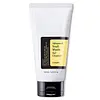What's inside
What's inside
 Key Ingredients
Key Ingredients

 Benefits
Benefits

 Concerns
Concerns

 Ingredients Side-by-side
Ingredients Side-by-side

Water
Skin ConditioningAcrylates Copolymer
Butylene Glycol
HumectantGlycerin
HumectantDisodium Laureth Sulfosuccinate
CleansingSodium Cocoyl Isethionate
Cleansing1,2-Hexanediol
Skin ConditioningCoco-Glucoside
CleansingLauryl Betaine
CleansingSnail Secretion Filtrate
Skin ConditioningArginine
MaskingTromethamine
BufferingPotassium Cocoyl Glycinate
Parfum
MaskingCarbomer
Emulsion StabilisingSodium Chloride
MaskingEthylhexylglycerin
Skin ConditioningAcrylates/C10-30 Alkyl Acrylate Crosspolymer
Emulsion StabilisingSodium Polyacrylate
AbsorbentDisodium EDTA
Water, Acrylates Copolymer, Butylene Glycol, Glycerin, Disodium Laureth Sulfosuccinate, Sodium Cocoyl Isethionate, 1,2-Hexanediol, Coco-Glucoside, Lauryl Betaine, Snail Secretion Filtrate, Arginine, Tromethamine, Potassium Cocoyl Glycinate, Parfum, Carbomer, Sodium Chloride, Ethylhexylglycerin, Acrylates/C10-30 Alkyl Acrylate Crosspolymer, Sodium Polyacrylate, Disodium EDTA
Water
Skin ConditioningCocamidopropyl Betaine
CleansingPropylene Glycol
HumectantHydroxypropyl Methylcellulose
Emulsion StabilisingSodium Chloride
MaskingPhenoxyethanol
PreservativeGlycerin
HumectantDMDM Hydantoin
PreservativeSodium Benzoate
MaskingSodium Lauroyl Oat Amino Acids
CleansingDisodium EDTA
Polyquaternium-7
Potassium Hydroxide
BufferingButylene Glycol
HumectantIodopropynyl Butylcarbamate
PreservativeSqualene
EmollientFomes Officinalis Extract
Skin ProtectingEthylhexylglycerin
Skin ConditioningAvena Sativa Kernel Extract
AbrasiveTrehalose
HumectantUrea
BufferingLecithin
EmollientSalix Alba Bark Extract
AstringentGlycyrrhiza Glabra Root Extract
BleachingOpuntia Ficus-Indica Stem Extract
Skin ConditioningPentylene Glycol
Skin ConditioningSerine
MaskingTerminalia Ferdinandiana Fruit Extract
AntioxidantAlgin
MaskingAscorbyl Palmitate
AntioxidantBakuchiol
AntimicrobialBehenic Acid
CleansingCaprooyl Phytosphingosine
Skin ConditioningCaprooyl Sphingosine
Skin ConditioningCaprylyl Glycol
EmollientCeramide AP
Skin ConditioningCeramide EOP
Skin ConditioningCeramide Eos
Skin ConditioningCeramide NP
Skin ConditioningCeramide Ns
Skin ConditioningCeteareth-25
CleansingCetyl Alcohol
EmollientCholesterol
EmollientCitric Acid
BufferingDisodium Phosphate
BufferingGlyceryl Oleate
EmollientGlyceryl Polyacrylate
Glyceryl Stearate
EmollientMagnolia Grandiflora Leaf Extract
Skin ConditioningPEG-40 Hydrogenated Castor Oil
EmulsifyingPotassium Phosphate
BufferingPotassium Sorbate
PreservativePullulan
Sodium Hyaluronate
HumectantTocopherol
AntioxidantWater, Cocamidopropyl Betaine, Propylene Glycol, Hydroxypropyl Methylcellulose, Sodium Chloride, Phenoxyethanol, Glycerin, DMDM Hydantoin, Sodium Benzoate, Sodium Lauroyl Oat Amino Acids, Disodium EDTA, Polyquaternium-7, Potassium Hydroxide, Butylene Glycol, Iodopropynyl Butylcarbamate, Squalene, Fomes Officinalis Extract, Ethylhexylglycerin, Avena Sativa Kernel Extract, Trehalose, Urea, Lecithin, Salix Alba Bark Extract, Glycyrrhiza Glabra Root Extract, Opuntia Ficus-Indica Stem Extract, Pentylene Glycol, Serine, Terminalia Ferdinandiana Fruit Extract, Algin, Ascorbyl Palmitate, Bakuchiol, Behenic Acid, Caprooyl Phytosphingosine, Caprooyl Sphingosine, Caprylyl Glycol, Ceramide AP, Ceramide EOP, Ceramide Eos, Ceramide NP, Ceramide Ns, Ceteareth-25, Cetyl Alcohol, Cholesterol, Citric Acid, Disodium Phosphate, Glyceryl Oleate, Glyceryl Polyacrylate, Glyceryl Stearate, Magnolia Grandiflora Leaf Extract, PEG-40 Hydrogenated Castor Oil, Potassium Phosphate, Potassium Sorbate, Pullulan, Sodium Hyaluronate, Tocopherol
 Reviews
Reviews

Ingredients Explained
These ingredients are found in both products.
Ingredients higher up in an ingredient list are typically present in a larger amount.
Butylene Glycol (or BG) is used within cosmetic products for a few different reasons:
Overall, Butylene Glycol is a safe and well-rounded ingredient that works well with other ingredients.
Though this ingredient works well with most skin types, some people with sensitive skin may experience a reaction such as allergic rashes, closed comedones, or itchiness.
Learn more about Butylene GlycolDisodium EDTA plays a role in making products more stable by aiding other preservatives.
It is a chelating agent, meaning it neutralizes metal ions that may be found in a product.
Disodium EDTA is a salt of edetic acid and is found to be safe in cosmetic ingredients.
Learn more about Disodium EDTAEthylhexylglycerin (we can't pronounce this either) is commonly used as a preservative and skin softener. It is derived from glyceryl.
You might see Ethylhexylglycerin often paired with other preservatives such as phenoxyethanol. Ethylhexylglycerin has been found to increase the effectiveness of these other preservatives.
Glycerin is already naturally found in your skin. It helps moisturize and protect your skin.
A study from 2016 found glycerin to be more effective as a humectant than AHAs and hyaluronic acid.
As a humectant, it helps the skin stay hydrated by pulling moisture to your skin. The low molecular weight of glycerin allows it to pull moisture into the deeper layers of your skin.
Hydrated skin improves your skin barrier; Your skin barrier helps protect against irritants and bacteria.
Glycerin has also been found to have antimicrobial and antiviral properties. Due to these properties, glycerin is often used in wound and burn treatments.
In cosmetics, glycerin is usually derived from plants such as soybean or palm. However, it can also be sourced from animals, such as tallow or animal fat.
This ingredient is organic, colorless, odorless, and non-toxic.
Glycerin is the name for this ingredient in American English. British English uses Glycerol/Glycerine.
Learn more about GlycerinChances are, you eat sodium chloride every day. Sodium Chloride is also known as table salt.
This ingredient has many purposes in skincare: thickener, emulsifier, and exfoliator.
You'll most likely find this ingredient in cleansers where it is used to create a gel-like texture. As an emulsifier, it also prevents ingredients from separating.
There is much debate on whether this ingredient is comedogenic. The short answer - comedogenic ratings don't tell the whole story. Learn more about comegodenic ratings here.
The concensus about this ingredient causing acne seems to be divided. Research is needed to understand if this ingredient does cause acne.
Scrubs may use salt as the primary exfoliating ingredient.
Learn more about Sodium ChlorideWater. It's the most common cosmetic ingredient of all. You'll usually see it at the top of ingredient lists, meaning that it makes up the largest part of the product.
So why is it so popular? Water most often acts as a solvent - this means that it helps dissolve other ingredients into the formulation.
You'll also recognize water as that liquid we all need to stay alive. If you see this, drink a glass of water. Stay hydrated!
Learn more about Water